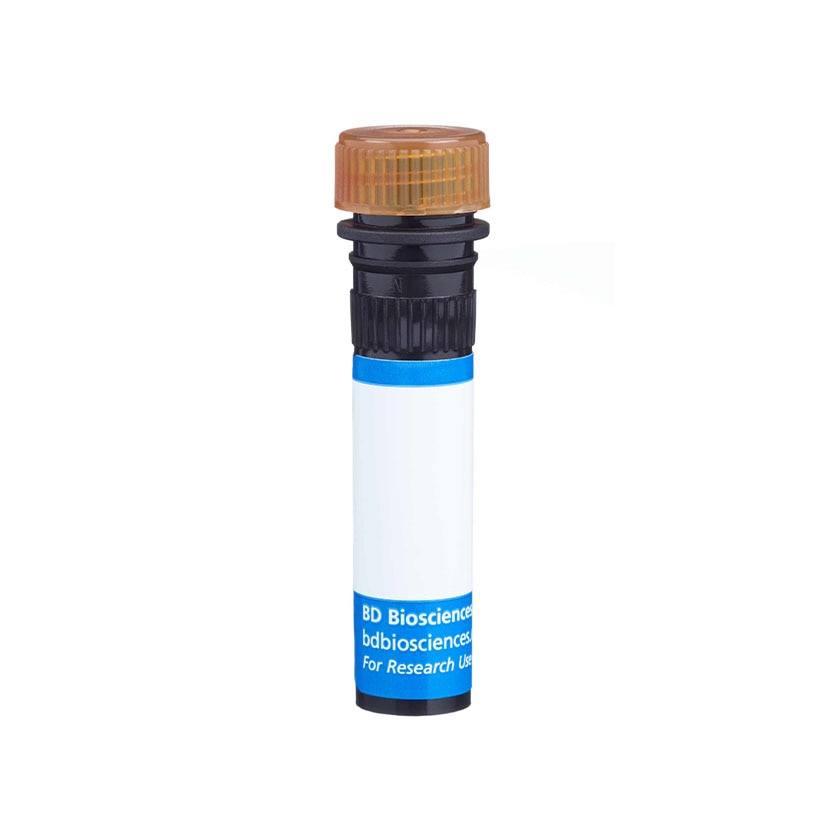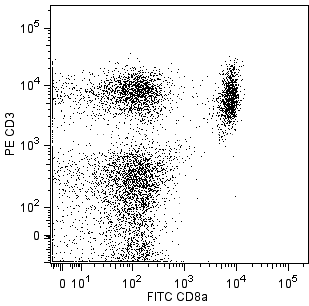Old Browser
This page has been recently translated and is available in French now.
Looks like you're visiting us from {countryName}.
Would you like to stay on the current country site or be switched to your country?




Flow cytometric analysis of the T-cell receptor (TcR) β-chain on mouse splenocytes. Left Panel: Splenocytes from C57BL/6 mice were stained with either a PerCP-Cy™5.5 Hamster IgG2, λ1 isotype control (shaded) (Cat. No. 550762) or with the PerCP-Cy™5.5 Hamster Anti-Mouse TcR β-chain antibody (unshaded). Middle and Right Panels: Splenocytes from C57BL/6 mice were stained with both a FITC Rat Anti-Mouse CD4 antibody (Cat.No. 553047) and a FITC Rat Anti-Mouse CD8a antibody (Cat.No. 553031) in conjunction with either a PerCP-Cy™5.5 Hamster IgG2, λ1 isotype control (middle panel) or the PerCP-Cy™5.5 Hamster Anti-Mouse TcR β-chain antibody (right panel). Histograms and dot plots were derived from gated events based on light scattering characteristics for splenocytes. Flow cytometry was performed on a BD™ LSR II flow cytometry system.


BD Pharmingen™ PerCP-Cy™5.5 Hamster Anti-Mouse TCR β Chain

Regulatory Status Legend
Any use of products other than the permitted use without the express written authorization of Becton, Dickinson and Company is strictly prohibited.
Preparation And Storage
Product Notices
- Since applications vary, each investigator should titrate the reagent to obtain optimal results.
- An isotype control should be used at the same concentration as the antibody of interest.
- Please observe the following precautions: Absorption of visible light can significantly alter the energy transfer occurring in any tandem fluorochrome conjugate; therefore, we recommend that special precautions be taken (such as wrapping vials, tubes, or racks in aluminum foil) to prevent exposure of conjugated reagents, including cells stained with those reagents, to room illumination.
- Cy is a trademark of Amersham Biosciences Limited. This conjugated product is sold under license to the following patents: US Patent Nos. 5,486,616; 5,569,587; 5,569,766; 5,627,027.
- This product is subject to proprietary rights of Amersham Biosciences Corp. and Carnegie Mellon University and made and sold under license from Amersham Biosciences Corp. This product is licensed for sale only for research. It is not licensed for any other use. If you require a commercial license to use this product and do not have one return this material, unopened to BD Biosciences, 10975 Torreyana Rd, San Diego, CA 92121 and any money paid for the material will be refunded.
- PerCP-Cy5.5 is optimized for use with a single argon ion laser emitting 488-nm light. Because of the broad absorption spectrum of the tandem fluorochrome, extra care must be taken when using dual-laser cytometers, which may directly excite both PerCP and Cy5.5™. We recommend the use of cross-beam compensation during data acquisition or software compensation during data analysis.
- PerCP-Cy5.5–labelled antibodies can be used with FITC- and R-PE–labelled reagents in single-laser flow cytometers with no significant spectral overlap of PerCP-Cy5.5, FITC, and R-PE fluorescence.
- Caution: Sodium azide yields highly toxic hydrazoic acid under acidic conditions. Dilute azide compounds in running water before discarding to avoid accumulation of potentially explosive deposits in plumbing.
- For fluorochrome spectra and suitable instrument settings, please refer to our Multicolor Flow Cytometry web page at www.bdbiosciences.com/colors.
- Please refer to www.bdbiosciences.com/us/s/resources for technical protocols.
Companion Products
.png?imwidth=320)

The H57-597 antibody reacts with a common epitope of the β chain of the T-cell Receptor (TCR) complex on αβ TCR-expressing thymocytes, peripheral T lymphocytes, NK1.1+ thymocytes, and NK-T cells of all mouse strains tested. It does not react with γδ TCR-bearing T cells. In the fetal and adult thymus, the TCR β-chain may form homodimers or pair with the pre-TCR α-chain on the surface of immature thymocytes before TCR α-chain expression. Plate-bound or soluble H57-597 antibody activates αβ TCR-bearing T cells, and plate-bound mAb can induce apoptotic death.

Development References (19)
-
Atsuta N, Nishimura H, Nakamura N, Emoto M, Iwatsuki T, Yoshikai Y. Diversity of V gamma gene segments rearranged to the J gamma 4 gene in mice. J Immunol. 1995; 154(2):676-684. (Biology). View Reference
-
Bendelac A, Killeen N, Littman DR, Schwartz RH. A subset of CD4+ thymocytes selected by MHC class I molecules. Science. 1994; 263(5154):1774-1778. (Biology). View Reference
-
Bonneville M, Itohara S, Krecko EG, et al. Transgenic mice demonstrate that epithelial homing of gamma/delta T cells is determined by cell lineages independent of T cell receptor specificity. J Exp Med. 1990; 171(4):1015-1026. (Biology). View Reference
-
Castro JE, Listman JA, Jacobson BA, et al. Fas modulation of apoptosis during negative selection of thymocytes. Immunity. 1996; 5(6):617-627. (Biology). View Reference
-
Davenport C, Kumar V, Bennett M. Rapid rejection of H2k and H2k/b bone marrow cell grafts by CD8+ T cells and NK cells in irradiated mice. J Immunol. 1995; 155(8):3742-3749. (Biology). View Reference
-
Gascoigne NR. Transport and secretion of truncated T cell receptor beta-chain occurs in the absence of association with CD3. J Biol Chem. 1990; 265(16):9296-9301. (Biology). View Reference
-
Groettrup M, von Boehmer H. T cell receptor beta chain dimers on immature thymocytes from normal mice. Eur J Immunol. 1993; 23(6):1393-1396. (Biology). View Reference
-
Kubo RT, Born W, Kappler JW, Marrack P, Pigeon M. Characterization of a monoclonal antibody which detects all murine alpha beta T cell receptors. J Immunol. 1989; 142(8):2736-2742. (Immunogen). View Reference
-
Lefrancois L. Phenotypic complexity of intraepithelial lymphocytes of the small intestine. J Immunol. 1991; 147(6):1746-1751. (Biology). View Reference
-
Ohno H, Ono S, Hirayama N, Shimada S, Saito T. Preferential usage of the Fc receptor gamma chain in the T cell antigen receptor complex by gamma/delta T cells localized in epithelia. J Exp Med. 1994; 179(1):365-369. (Biology). View Reference
-
Saint-Ruf C, Panigada M, Azogui O, Debey P, von Boehmer H, Grassi F. Different initiation of pre-TCR and gammadeltaTCR signalling. Nature. 2000; 406(6795):524-527. (Biology). View Reference
-
Saint-Ruf C, Ungewiss K, Groettrup M, Bruno L, Fehling HJ, von Boehmer H. Analysis and expression of a cloned pre-T cell receptor gene. Science. 1994; 266(5188):1208-1212. (Biology). View Reference
-
Skeen MJ, Ziegler HK. Induction of murine peritoneal gamma/delta T cells and their role in resistance to bacterial infection. J Exp Med. 1993; 178(3):971-984. (Biology). View Reference
-
Takizawa F, Kinet JP, Adamczewski M. Binding of phycoerythrin and its conjugates to murine low affinity receptors for immunoglobulin G. J Immunol Methods. 1993; 162(2):269-272. (Biology). View Reference
-
Vicari AP, Zlotnik A. Mouse NK1.1+ T cells: a new family of T cells. Immunol Today. 1996; 17(2):71-76. (Biology). View Reference
-
Waggoner AS, Ernst LA, Chen CH, Rechtenwald DJ. PE-CY5. A new fluorescent antibody label for three-color flow cytometry with a single laser. Ann N Y Acad Sci. 1993; 677:185-193. (Biology). View Reference
-
Wagner DH Jr, Hagman J, Linsley PS, Hodsdon W, Freed JH, Newell MK. Rescue of thymocytes from glucocorticoid-induced cell death mediated by CD28/CTLA-4 costimulatory interactions with B7-1/B7-2. J Exp Med. 1996; 184(5):1631-1638. (Biology). View Reference
-
van Vugt MJ, van den Herik-Oudijk IE, van de Winkle JG. Binding of PE-CY5 conjugates to the human high-affinity receptor for IgG (CD64). Blood. 1996; 88(6):2358-2361. (Biology). View Reference
-
van der Heyde HC, Elloso MM, Chang WL, Kaplan M, Manning DD, Weidanz WP. Gamma delta T cells function in cell-mediated immunity to acute blood-stage Plasmodium chabaudi adami malaria. J Immunol. 1995; 154(8):3985-3990. (Biology). View Reference
Please refer to Support Documents for Quality Certificates
Global - Refer to manufacturer's instructions for use and related User Manuals and Technical data sheets before using this products as described
Comparisons, where applicable, are made against older BD Technology, manual methods or are general performance claims. Comparisons are not made against non-BD technologies, unless otherwise noted.
For Research Use Only. Not for use in diagnostic or therapeutic procedures.
Report a Site Issue
This form is intended to help us improve our website experience. For other support, please visit our Contact Us page.